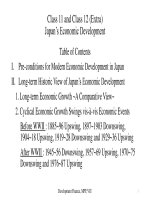Economic growth and economic development 201
Bạn đang xem bản rút gọn của tài liệu. Xem và tải ngay bản đầy đủ của tài liệu tại đây (45.17 KB, 1 trang )
Introduction to Modern Economic Growth
.
CAN
AUS
10
USA
SGP
HKG
Log GDP per capita, PPP, in 1995
NZL
CHL
ARG
URY
BWA
BRA
9
VEN
ZAF
GAB MEX
MYS
KNA
PAN
COL TTO
CRI
NAM
SUR
GUY
8
PRY
SWZ
CPV BOL
ZWE
LSO
7
BHS
BRB
LCA
ECU
GRD
PER
BLZ
DOM
DMA
VCT
GTM
PHL
SLV
AGO
HND
NIC
CMR
COG
DZA
JAM
IDN
MAR
EGY
LKA
GIN
CIV
MRTGHA
SEN
COM
GMB
TGOVNM
CAF
HTILAO
BEN
KEN
UGA
ZAR
BFA
TCD
MDG
NGA
ZMB
NER
ERI
MLI
MWI MOZ
TZA
TUN
IND
SDN PAK
NPL BGD
BDI
RWA
SLE
6
-5
0
Log Population Density in 1500
5
Figure 4.6. Reversal of Fortune: population density in 1500 versus
income per capita in 1995 them on the former European colonies.
the late eighteenth and early nineteenth centuries. Moreover, a wealth of qualitative
and quantitative evidence suggests that this went hand in hand with industrialization (see, for example, Acemoglu, Johnson and Robinson, 2002). Figure 4.8 shows
average urbanization in colonies with relatively low and high urbanization in 1500.
The initially high-urbanization countries have higher levels of urbanization and prosperity until around 1800. At that time the initially low-urbanization countries start
to grow much more rapidly and a prolonged period of divergence begins.
These patterns are clearly inconsistent with simple geography based views of
relative prosperity. In 1500 it was the countries in the tropics which were relatively
prosperous, today it is the reverse. This makes it implausible to base a theory of relative prosperity on the intrinsic poverty of the tropics, climate, disease environments
or other fixed characteristics.
Nevertheless, following Diamond (1997), one could propose what Acemoglu,
Johnson and Robinson (2002a) call a “sophisticated geography hypothesis,” which
claims that geography matters but in a time varying way. For example, Europeans
187









